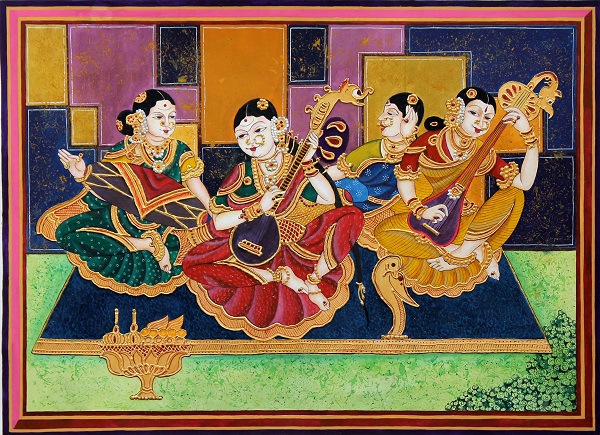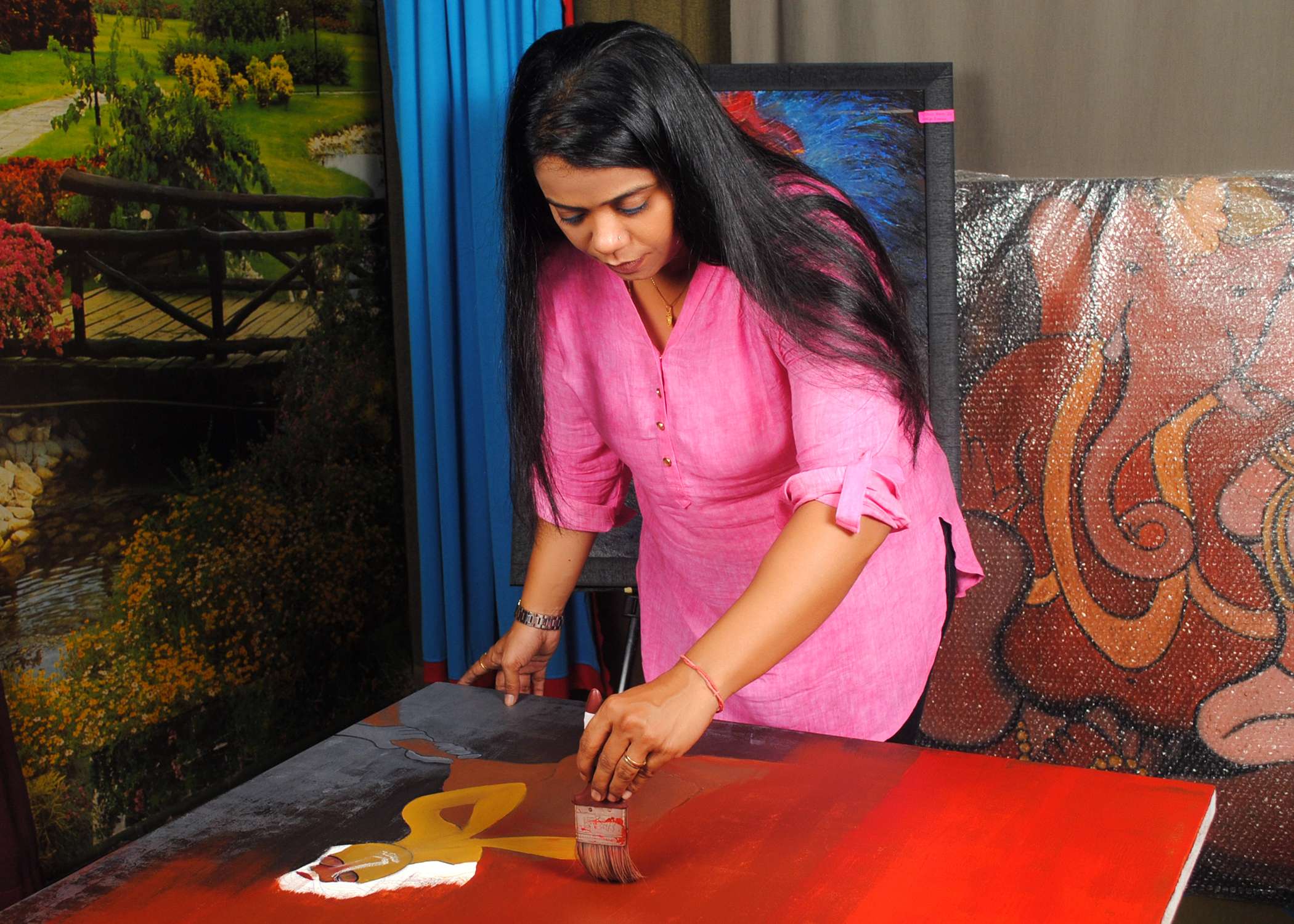
Do you have a monotonous interior decor that requires a traditional touch? If yes, then you should consider the addition of traditional paintings into your living space. Gone are the days when bland walls and monotonous interior decor did the job. In today’s modern era, home decor is not just a regular activity but a personal endeavor for individuals. Making your interior lively with paintings not only enhances the overall aesthetics but also adds depth and dimension.
“A work of art which did not begin in emotion is not art.” This famous quote by Paul Cezanne represents art as an emotion rather than just being anything random. Having an eye-catching art in your ambiance enhances your overall lifestyle. While there are many forms of artwork and paintings, the most common types of artwork preferred by individuals are traditional. In more recent times, Indian art has evolved to incorporate diverse styles and mediums. Modern and contemporary art movements have emerged, exploring themes of identity, social issues, and globalization. Contemporary Indian artists often take inspiration from traditional Indian art forms to create fusion artworks that can easily fit into modern homes as Indian wall decor pieces. Indian artists have gained international recognition and have contributed significantly to the global art scene.
It could be tricky for many people to buy the most suitable artwork and incorporate the same in their interiors. Thus, to help you in this task, we will delve into the details of how you can choose the right artwork and incorporate it. But before we dive into the details, let’s clear our understanding of traditional art.
Understanding Traditional Art
Traditional paintings have an extensive heritage, rooted in different cultures around the world. From classical European masterpieces to vibrant Asian brushwork, these artworks reflect the diverse artistic expressions of humanity. Understanding the history and cultural context of traditional paintings enhances the appreciation of their aesthetic value. In more recent times, traditional Indian art has evolved to incorporate diverse styles and mediums. Modern and contemporary art movements have emerged, exploring themes of identity, social issues, and globalization. Contemporary Indian artists often take inspiration from traditional Indian art forms to create fusion artworks that can easily fit into modern homes as Indian wall decor pieces. Indian artists have gained international recognition and have contributed significantly to the global art scene.
Choosing the Right Traditional Painting
Choosing traditional paintings that perfectly blend with your interior is not always easy. It takes you into consideration various factors while buying artwork from an online art gallery. Let us dive into the details and have a look at all the factors you need to consider.
1.Theme and Style
Begin by identifying a specific theme or style that suits your taste and interest. It is essential that the theme you decide should complement your existing decor. Understanding your theme will guide selection, whether it is landscapes, portraits, abstract, or any other traditional painting. Additionally, you can consider the mood you want. This can be serene, vibrant, or sophisticated. This ensures the painting resonates with the ambiance you desire.
2.Consider the Space
Before purchasing a traditional artwork for your interior, always think about where the painting will be displayed. This includes considering the size, color scheme, and overall aesthetic of the room. A large, vibrant piece might serve as a focal point in a living room, while a smaller, more subdued painting may be better suited for a cozy bedroom. Pay attention to the existing decor and ensure that the painting complements the overall surroundings.
3.Artistic Style and Genre
Traditional painting encompasses a wide range of styles and genres, such as realism, impressionism, abstract, and more. You should familiarize yourself with different styles to find one that resonates with you. Choosing the wrong style may not create an aesthetic impact. If you have a specific theme or subject matter in mind, explore paintings that align with your preferences.
4.Budget and Investment Considerations
While all other factors play a key role in choosing the best artwork, it is impossible to miss out on budgetary and financial parameters. You can always set a budget for your purchase and explore options within that range. Keep in mind that art can be both a personal enjoyment and a potential investment. While you don't need to break the bank, investing in a well-regarded artist or a piece with potential future value could be a wise decision.
Tips for Incorporating Traditional Paintings
Now that you are all set to revamp your existing decor with a traditional touch, here are some tips that you can use while incorporating traditional artwork.
1.Decide a Theme
There are many Indian traditional artworks that have survived through generations and are still making their presence felt. However, you will find certain styles more attractive than the rest and as a result, you will be more inclined to them. In order to make a gallery wall, you can opt for pieces belonging to either one or all of your preferred art styles. While attempting to mix two painting styles on your art gallery wall, choose the ones that are somehow similar to each other. Moreover, you can also think of blending different Indian traditional styles but take some expert advice before finalizing your decision.
2.Experiment with Different Sizes and Shapes
If there is one thing that requires your maximum effort, then it is this one. Distinctively shaped paintings look like an artist’s dream or a nightmare depending on the way they are placed. If you’re looking for a symmetrical, then choose the frames which are similar but if you’re more inclined towards achieving an abstract look, then use your imagination to mix and match the differently shaped paintings to create your own personalized gallery wall. You can also try to form a collage out of multiple paintings if that suits your taste.
3.Coordinate it with Colors
Before proceeding to buy traditional artwork from a local store or online art gallery, give a thought to the color of your wall. It is always advisable to choose a traditional artwork that perfectly blends with your interiors. The overall theme of your living space and the color combination also play a key role in this matter.
4.Statement Furniture Pairing
You can effectively use traditional paintings to complement statement furniture pieces. For instance, a classic landscape painting can enhance the elegance of a vintage-inspired sofa, creating a cohesive and sophisticated atmosphere. You can also consider the theme of the artwork in relation to the function of the space. A lively, colorful painting might be perfect for a social area, while a serene landscape could be ideal for a bedroom or study.
Conclusion
Traditional paintings have an enduring charm that transcends time and trends. Infusing a touch of tradition into your home decor not only adds visual appeal but also connects you with the rich cultural heritage of art. Whether you prefer the classical elegance of European masterpieces, the serene beauty of Asian brushwork, or the vibrant narratives of Indian art, traditional paintings offer a myriad of options to suit your taste.
By understanding the cultural context, choosing artworks thoughtfully, and integrating them creatively into modern spaces, you can create a perfect blend that celebrates both the past and the present. Traditional paintings serve as more than mere decorations; they become windows to different worlds, sparking conversations and evoking emotions. So, go ahead and embark on a journey to infuse your home with the timeless allure of traditional paintings, creating a space that reflects not only your style but also the rich tapestry of human creativity across centuries. If you wish to revamp your existing interior decor with traditional artwork from an online art gallery, consider checking out our collections, featured by highly skilled artists.
FAQs:
Q1 How is traditional art made?
Traditional art is crafted using various methods and techniques. Artists typically start with a basic sketch and infuse vibrant colors into the artwork. Artists can also use pencils, charcoal, or ink to create splendid artwork. The artists apply various layers to add definition and depth to their artwork. Traditional art requires skills, patience, and a deep understanding of the chosen medium, showcasing the artist’s creativity and craftsmanship.
Q2 What makes traditional painting a folk art??
A painting is considered folk art when it reflects the traditional and cultural expressions of a specific community. What makes it special is that it is often created by local or self-taught artists who are inspired by their heritage and everyday life. Folk art paintings typically portray regional themes, symbols, and stories, showing the identity and values of a particular culture. They often use bright colors, patterns, and simple shapes to tell stories or show historical events. These paintings have a unique charm because they are authentic and meaningful to the community they come from. Folk art paintings capture the essence of a community's artistic traditions, making them a valuable part of their cultural heritage.
Q3 Where can I place Indian Traditional Paintings?
You can incorporate traditional paintings at various locations to enhance the overall aesthetics. You can consider hanging them in living rooms, dining areas, hallways, or bedrooms. The lobby and entryways also provide excellent spaces for showcasing traditional art. While hanging the artworks, always ensure there is adequate light that can illuminate them. In professional settings such as offices or waiting areas. Ultimately, the key is to integrate traditional paintings where they complement the overall decor and captivate attention without overwhelming the space.





















